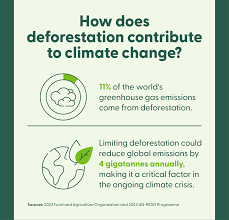Deforestation plays a crucial role in climate change by contributing to the release of large amounts of carbon dioxide into the atmosphere. Trees naturally absorb carbon, and when forests are cut down or degraded, this carbon is released, exacerbating global warming.
This environmental loss also reduces the planet’s ability to mitigate climate change by limiting the amount of carbon that can be absorbed.
The “Reducing Emissions from Deforestation and Forest Degradation” (REDD+) program offers a promising solution by incentivizing developing countries to reduce deforestation, conserve forests, and implement sustainable land-use practices.
Through REDD+, countries can receive financial support to protect forests, which in turn helps reduce global emissions and protect biodiversity, providing an essential tool in the fight against climate change.
Read More: How Does Deforestation Contribute to Climate Change, and How Can REDD+ Help Reduce Its Impact?
The Scale of Deforestation and Its Impact on Climate Change
Deforestation involves the deliberate removal or thinning of trees and forests, a practice that significantly contributes to climate change. When forests are cleared, the carbon stored within trees is released back into the atmosphere as carbon dioxide, a potent greenhouse gas that accelerates global warming.
Over the past decade, the most extensive deforestation has occurred in the humid tropics, particularly in Africa, followed by South America.
According to the UN Food and Agriculture Organization (FAO), approximately 420 million hectares of forest were lost between 1990 and 2020, with 178 million hectares lost net of afforestation and natural forest expansion.
Although the annual rate of deforestation has decreased, it still averaged 10 million hectares per year from 2015 to 2020. The primary driver of this deforestation is the global demand for agricultural commodities.
Agribusinesses clear vast areas of forest to cultivate high-value crops like palm oil and soy, or for cattle ranching.Land-use change, particularly deforestation, is responsible for 12–20% of global greenhouse gas emissions.
Additionally, forest degradation and the destruction of tropical peatlands further contribute to these emissions.
In some regions, such as the southeastern Amazon Rainforest, deforestation and degradation have caused forests to transition from carbon “sinks”—which absorb more carbon than they emit—to carbon “sources,” releasing more carbon than they capture.
The Role of REDD+ in Addressing Deforestation and Climate Change
Scientists have long recognized the critical role forests play in mitigating climate change.
In response, policymakers have developed a suite of strategies, collectively known as “Reducing Emissions from Deforestation and Forest Degradation” (REDD), designed to incentivize governments, agribusinesses, and local communities to protect and even expand forest cover rather than diminish it.
The “plus” in REDD+ refers to the inclusion of conservation efforts, sustainable forest management, and the enhancement of forest carbon stocks in developing countries.
Under the REDD+ framework, countries, communities, and individual landowners are offered financial incentives in exchange for reducing deforestation rates and implementing activities such as reforestation and sustainable forestry practices.
Properly involving local communities in the process can also help alleviate rural poverty.The principles of REDD+ were further solidified within the Paris Agreement on climate change, reinforcing its global significance.
REDD+ initiatives are implemented through various mechanisms, including those managed by the United Nations (UN-REDD) and the World Bank’s Forest Carbon Partnership Facility.
In addition, REDD+ funding is a key component of international climate finance discussions, often channeled through voluntary carbon markets and actions supported by both for-profit and non-profit organizations.
The Fairness, Effectiveness, and Efficiency of REDD+
While REDD+ has demonstrated significant potential in reducing CO2 emissions, it faces several challenges that raise concerns about its fairness, effectiveness, and efficiency.
One major issue is the perceived inequity of a program that seeks to address emissions from some of the world’s poorest communities, while emissions continue to rise in wealthier nations.
Additionally, some developing countries may be cautious about foreign involvement in their land-use policies, fearing loss of sovereignty.
Operational challenges also persist, such as the difficulty in accurately monitoring and measuring deforestation rates, and attributing changes in forest cover directly to REDD+ interventions.
Variations in local contexts and institutional capacities mean that not all countries with tropical forests have the infrastructure or resources to effectively tackle these issues.
How Much REDD+ Finance Has Been Pledged?
Global estimates of the cost to fully implement REDD+ vary, with some estimates suggesting that at least US$15 billion annually is needed to combat tropical deforestation worldwide. However, current funding remains far from this target.
A 2020 review indicated that between 2015 and 2019, only an average of US$220 million per year in funding was approved for REDD+ projects. The Amazon Fund, with US$720 million in approved projects, remains the largest dedicated REDD+ initiative.
The challenge of securing sufficient finance for forest protection is compounded by the fact that alternative land uses, such as palm oil plantations, often provide more immediate financial returns.
As a result, many experts advocate for scaling up financial commitments to REDD+, though there are concerns that even with increased funding, REDD+ may struggle to compete with the profitability of other land-use options, particularly when commodity prices rise.
Regardless of the future trajectory of REDD+, experts agree that efforts should prioritize areas that can offer the most efficient CO2 reductions—such as tropical peat swamp forests—while also providing opportunities for biodiversity conservation and poverty alleviation.
Frequently Asked Questions (FAQs)
What is REDD+?
REDD+ stands for Reducing Emissions from Deforestation and Forest Degradation. It is a global initiative designed to provide financial incentives to developing countries to reduce deforestation and forest degradation, and promote sustainable forest management and conservation.
How does REDD+ work?
REDD+ works by offering financial incentives to countries, communities, and landowners to slow deforestation, stop illegal logging, and implement activities that promote reforestation and sustainable forest management. These actions help mitigate climate change by reducing CO2 emissions and enhancing carbon stocks in forests.
Why is REDD+ important for tackling climate change?
Forests act as carbon sinks, absorbing significant amounts of CO2. When forests are cleared, the carbon stored in trees is released back into the atmosphere, contributing to global warming. REDD+ helps mitigate climate change by reducing emissions from deforestation and enhancing forest carbon stocks.
How does REDD+ benefit developing countries?
REDD+ provides financial support to developing countries to help them protect their forests. It also offers the opportunity for sustainable development by creating jobs in conservation, boosting local economies, and potentially reducing poverty in rural areas where deforestation is a significant issue.
What are the challenges of REDD+?
Some challenges of REDD+ include issues of fairness, operational difficulties in monitoring and measuring deforestation rates, and concerns about foreign interference in land-use policies. Additionally, the financial resources pledged for REDD+ have not been sufficient to fully address global deforestation, and competing land uses, such as agriculture, may undermine the initiative.
How much funding has been pledged to REDD+?
While estimates suggest that US$15 billion annually is required to fully address tropical deforestation, funding has remained well below this target. From 2015 to 2019, the average approved funding was about US$220 million per year. The Amazon Fund remains the largest dedicated REDD+ fund, with US$720 million in approved projects.
Conclusion
REDD+ represents a critical component in the global effort to combat climate change by addressing the significant role deforestation plays in CO2 emissions. Through financial incentives, it encourages countries, communities, and landowners to adopt sustainable forest management practices, halt deforestation, and promote reforestation. While REDD+ shows promise, challenges remain, including issues of fairness, the complexity of implementation, and the need for increased financial support.

